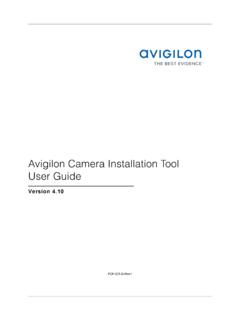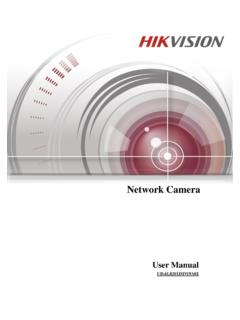Transcription of Network / IP Camera - RIT
1 PowerLanWLan Network / IP CameraUser ManualPrefaceCongratulations on your purchase of this product. Read this manual carefully and keep it in a safe place for future this ManualThis user manual has been designed to help you make the most of your IP Camera and its many features and functions. Information in this document has been carefully checked for accuracy; however, no guarantee is given to the correctness of the contents. The information in this document is subject to change without Copyright 2006 This manual contains proprietary information, protected by copyright. All rights of ContentsIntroduction .. 1 Key Features .. 1 Package Contents .. 2 Product 3 Front View ..3 Back View ..3 Bottom View ..3 Indicators .. 4 System Requirements .. 4 Getting Started .. 5 Software Installation .. 5 Hardware Installation .. 6 Assembling the Stand .. 6 Connecting to a Network .. 7 Connecting Power .. 7 Initial Configuration .. 8 Using an Internet Browser to Connect to the 10 Using and Configuring.
2 11 Web Page Layout .. 11 Saving an Image .. 12 Recording a Video 13 Viewing Multiple Cameras via the 4-Port 14 Configuring the Camera .. 15 Configuring Basic 16 Configuring System Settings .. 16 Firmware Upgrade .. 17 Others Settings .. 18 Configuring Network Settings .. 19 Wireless Settings .. 20 PPPoE Settings .. 21 DDNS 22 Configuring User Settings ..23 Configuring Video Monitor Setting ..25 Configuring Advanced Settings .. 25 Configuring FTP Mail Server GPIO Tcp Message Settings ..28 Configuring Breach Manager Settings .. 30 Specifications .. 30 Maintenance .. 33 Troubleshooting .. 34 Key Features1 IntroductionThis section covers unpacking your new IP Camera , its key fea-tures, and basic technical information about the product. Refer to later chapters for information on setting up and configuring the product in more Features 640x480 (VGA), 320x240 (QVGA), 160x120 (QQVGA) resolutions 307,200 effective pixels Max. frame rate 25fps at VGA resolution mm, lens Configuration and viewing via standard internet browser Built-in microphone Motion detection feature Email and ftp alert feature Automatic infrared night vision function External GPIO sensor inputPackage Contents2 Package ContentsThe package should contain all the following.
3 If anything is missing or appears damaged, contact your dealer Start GuideIP Camera moduleMounting bracketRJ-45 cableMounting screwsAC power adaptorQuick start guideCD-ROM with manual and softwareProduct Views3 Product ViewsUse the following illustrations to familiarize yourself with the Camera and identify each of the ViewBack ViewBottom ViewPowerLanWLanLight SensorPower IndicatorLAN IndicatorWLAN IndicatorMicrophoneNight Vision IR LEDsLens AssemblyLan 10 / 100 GPIO 1DO / 2 DIDC 5 VDI1 DI2 NOCOMNCGPIO PortConnectorsGPIO PortDC-IN SocketRJ-45 LAN ConnectorWireless Receiver AntennaMounting PointSystem Requirements4 IndicatorsThe following table shows what each of the LED indicators RequirementsThe system requires an ethernet port/wireless connection and an IP view the IP Camera images, your computer must have: Microsoft Windows 98, ME, , 2000, or XP operating system. A Mac or Linux based machine is also compatible. Microsoft Internet Explorer , or activity indicatorPowerGreenPower indicatorSoftware Installation5 Getting StartedRead this section of the manual to learn how to set up your IP Camera and use its basic InstallationYou do not need to install any software for simply viewing images from the IP Camera , but you will need to use the sup-plied auto scan software to set the Camera up for the first time and find it on the install the auto scan software:1.
4 Insert the supplied CD-ROM into your CD-ROM If the installation does not start automatically, use a file explorer application to execute in the root folder on the Follow the on-screen instructions. 4. Install IPCam Master to use IPCam Master. Hardware Installation6 Hardware InstallationRead this section to learn how to install the Camera and connect it to a the StandThe Camera can be assembled in two different ways; either from the top of the unit or the the stand and fix it to the cam-era as the three screws and plugs provided to fix the stand bracket to a wall, ceiling or other convenient fixing stand can be adjusted to allow the Camera a full 360 of rotation and a pan and tilt the above steps to mount from the base of the unit, attaching the stand bracket to the mounting point on the base of the Ensure the Camera is fixed securely otherwise it may fall and cause injury. The Camera is not waterproof and should not be mounted outside or in a position where it could become Installation7 Connecting to a NetworkThe IP Camera can be connected to an Ethernet Network using the RJ-45 port as shown.
5 Connect the Camera to an Ethernet hub or switch using a standard cable. You can also connect the Camera directly to a computer using the supplied PowerConnect the power adapter to the DC-IN socket on the Camera as only the power adapter with the Camera . Using another adapter, not recommended by the manufac-turer, may damage the Camera and invalidate the a n 1 0/ 1 0 0 GPIO IDO/2 DIDC 5VL a n 1 0/ 1 0 0 GPIO IDO/2 DIDC 5 VInitial Configuration8 Initial ConfigurationRead this section to learn how to configure and begin using the IP Camera . A complete description of the features and functions can be found in the next install the Camera on a Network , you first need to give it an IP address. Ask your Network administrator to obtain an IP address suitable for your Network , along with a netmask, the gateway address , and http the IP Camera to your Network or host PC as described in Connecting to a Network on page the IPCam Master the Update button to scan for your Camera .
6 A list of cam-eras connected to the Network will appear in the :Connecting the Camera to your Network before you have configured an IP address may cause problems such as address conflicts. To avoid these problems, connect the Camera to an isolated PC with a hub or cross-over cable to configure the Network Configuration9 Enter the IP address, netmask, gateway address and http port provided to you by your Network administrator:If you want to connect using DHCP, check the Enable DHCP the Submit button to update the Camera with the new the above steps have been completed, you can double click the name of the Camera in the display window to connect to it using your default browser. Alternatvely, you can connect to the Camera by entering the IP address in the browser address ListConifguration FieldsInitial Configuration10 Using an Internet Browser to Connect to the CameraRead this section to learn how to use your Internet browser to connect to the IP Camera , view images, and hear audio connect to the IP Camera using an Internet browser:Enter the IP address of the Camera in the browser address Page Layout11 Using and ConfiguringRead this chapter to learn how to operate the IP Camera and take advantage of the advanced features such as alerting, and ftp Page LayoutUse the menu bar on the left side of the screen to perform actions and enter the sub-menus:1.
7 Snap Image: Click to save the current Record AVI: Click to record an AVI video Configuration Setting: Click to enter the settings 4-port Viewer: Click to view the output of up to four other IP cameras on the Audio On/Off: Click to turn audio on or Motion Indicators: These indicators flash red and blue alternately when motion is the following sections for more information on each of these menu Page Layout12 Saving an ImageTo save the image currently displayed in the main window, do the following:Click the tab on the menu sidebar. A save dialog appears:Enter a filename, select a file type from the dropdown menu, and click the Page Layout13 Recording a Video ClipTo record a video clip (AVI file), do the following:Click the tab on the menu sidebar. A settings window appears:Enter the frame rate you want to record the duration of the the file prefix and the file path you want to save the file you want to record continuously, check the Continuous Recording the button to confirm all settings and begin recording.
8 The menu icon will turn red during Page Layout14 Viewing Multiple Cameras via the 4-Port FunctionTo view up to four cameras connected to your Network at one time, you can use the 4-port Camera view multiple cameras in the display window, do the follow-ing:Click the tab on the menu sidebar. The settings screen Basic Setting on the menu sidebar and then Monitor in the submenu. The 4-port monitor setting screen appears:Enter the IP address, port, login and password of each Camera you wish to view and check the Enable the button to confirm your the tab on the menu sidebar to return to the main the tab on the menu sidebar to switch to 4-port viewing the Camera15 Configuring the CameraRead this section of the manual to learn how to configure the IP Camera using the settings access the settings menus, do the following:Click the button on the menu sidebar. The main settings screen appears:There are two sub menus in the menu sidebar: Basic Setting and Advanced the Camera16 Configuring Basic SettingsRead this section to learn about all the settings and options under the Basic Setting sub System SettingsThe System submenu allows you to configure all system-related settings.
9 There are three main screens, accessed via the tabs at the top of the screen: Configuration, Firmware, and SettingsClick the Configuration tab to access the system configuration screen:Here is displayed all system information, including firmware ver-sion and device name, and is where you can configure date and time to either Sync with Time Server or Sync with PC Time. Check the radio button for the setting you wish to you select Sync with Time Server, choose your time zone, enter NTP server details, along with another server if neces-sary. You can also enable daylight saving time by checking the Daylight Saving Time the Camera17If you select Sync with PC Time, the current time displayed by your PC is the button to confirm your UpgradeClick the Firmware tab to access the firmware upgrade screen:Here you can upgrade the system firmware the button and locate the folder where the firmware update is the button to load the not upgrade the firmware version unless you are certain that it will improve your system performance.
10 Any unnecessary firmware upgrade may result in the Camera18 Others SettingsClick the Others tab to access the others screen:Here you can restore factory defaults and reboot the system Restore Factory Defaults, click the button to restore all factory defaults. A confirmation dialog appears. Click OK to Remote Reboot, click the button to reboot the system remotely. A confirmation dialog appears. Click OK to the Camer 19 Configuring Network SettingsThe Network submenu allows you to configure all Network -related settings. There are four main screens, accessed via the tabs at the top of the screen: Ethernet, Wireless, PPPoE, and SettingsClick the Ethernet tab to access the ethernet settings screen:Here you can configure all settings related to your ethernet, wireless, and DNS & HTTP port all the fields as required. You may not require all the fields. For instance, you will not need to complete the static IP address fields if you are installing the Camera on a Network that allocates addresses using the button to confirm your the Camera20 Wireless SettingsClick the Wireless tab to access the wireless settings screen:Here you can configure all settings related to Camera access to your wireless your Network allows for wireless connection, complete all the fields under Configuration to connect wirelessly.










